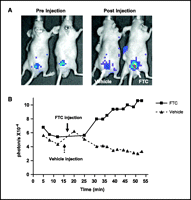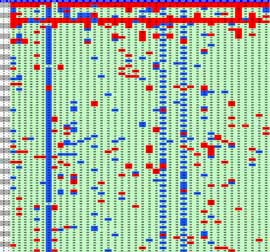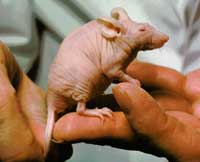 A New Center – Much research and discussion now is not centered around XMRV but around a prostate cancer cell line called 22RV1. More than anything else this cell line that is what is causing problems for XMRV.
A New Center – Much research and discussion now is not centered around XMRV but around a prostate cancer cell line called 22RV1. More than anything else this cell line that is what is causing problems for XMRV.
The 22RV1 cell line was created in 1999 in response to a need to study prostate cancer – a major cause of male mortality. Creating the cell line involved ‘passaging’ prostate cancer cells through nude mice tissues. At some point researchers were able to create a ‘cell-line’, a group of cells they could use to reliably grow prostate cancer cells and study them. The 22RV1 cell line has been used in over 200 studies since it was created in 1999.
Miller Enters the Scene and Produces a Seminal Finding– Ten years later and just nine months after the Science paper gamma retrovirologist and cancer researcher Dr. Dusty Miller found, to what he described as his immense surprise, that the 22RV1 prostate cancer cell line in his lab was producing a virus. When he took a closer look he found that it was producing XMRV and lots of it.
“Here we describe the detection of multiple integrated copies and high-level production of XMRV from 22Rv1 prostate carcinoma cells”.
The major finding, though, would turn out to be that it appeared to be producing the same strain as XMRV found in prostate cancer samples by Dr. Silverman.
Cloning of the gag gene revealed nearly exact matches to XMRV clone VP42, and phylogenetic analysis revealed that the 22Rv1 sequences clearly cluster with all previously cloned XMRV sequences by Silverman from his prostate cancer find. From these data, we conclude that the 22Rv1 virus is XMRV.
In the addendum to the paper Miller added further genetic evidence that he had found XMRV.
That further work showed that the virus produced by 22Rv1 cells is similar to XMRV over its entire length and not just over the gag region that we sequenced, further supporting our conclusion that the 22Rv1 virus is indeed XMRV.
With the discovery that a commonly used laboratory cell line was spewing out XMRV Miller warned of possible virus transmission to laboratory personnel and to other cells cultured in the lab. The implications of his short paper were not clear to everyone but Miller’s XMRV finding ultimately ended up, at least at this point, up turning the field.
A Dangerous Connection? -Miller provided preliminary area evidence that the virus the 22RV1 cell was producing was disturbingly similar to the virus putatively found by Silverman in human prostate cancer cells. The finding was potentially disturbing because viral infection in the human body usually results in significant genetic changes to the virus and that did not appear to have occurred. It wasn’t clear, however, whether Silverman’s strain had gotten in Miller’s 22RV1 cell line or if the 22RV1 cell line had produced Silverman’s virus.
The CFS- Prostate Cancer – 22RV1 Connection – The chronic fatigue syndrome research got dragged into the equation when the WPI’s Science paper reported that
in ‘all positive’ cases ‘the gag and env sequences were 99% similar to those previously reported for the Silverman’s prostate tumor-associated strains (VP62, VPf35, and VP42)’ and that the entire genomes of two XMRV strains they sequenced (CFS XMRV strains 1106 and 1178)…”were >99% identical in sequence to those detected in patients with prostate cancer.”
It was true that the WPI only fully sequenced two strains of XMRV but their finding that all 70 or so gag and env sequences were identical to the prostate cancer strains might suggest that the rest of the may not display much variation. Still the issue will not be resolved until more of the WPI’s XMRV strains are sequenced and analyzed.
The next step was to discover who was the first? Had the XMRV in the human samples made its way into the laboratory or had the laboratory strain made its way into the human samples? This is at least partially done by determining which strains contain more or less genetic variation than the others.
Genetic Analysis of All Published Strains – In Dec 2010 Hue took the next step and did an extensive genetic analysis of all the known XMRV strains including numerous strains found in the 22RV1 cell line and in prostate cancers and in the two strains found by the WPI. The analysis found that the XMRV produced by the 22RV1 cell line was more diverse genetically than the XMRV found in the prostate cancer and CFS patients.
 This was a remarkable finding given the diverse geographic origins of the patients which suggested that the virus had been in the human population for quite some time. Researchers in population genetics use genetic diversity to trace populations back to their source. We don’t need bones, for instance, to tell us that humans originated in Africa; the higher rates of human genetic diversity in Africa relative to the rest of the world, indicate where humans came from. Now Hue’s results were suggesting that all the XMRV strains came from the 22RV1 cell line.
This was a remarkable finding given the diverse geographic origins of the patients which suggested that the virus had been in the human population for quite some time. Researchers in population genetics use genetic diversity to trace populations back to their source. We don’t need bones, for instance, to tell us that humans originated in Africa; the higher rates of human genetic diversity in Africa relative to the rest of the world, indicate where humans came from. Now Hue’s results were suggesting that all the XMRV strains came from the 22RV1 cell line.
The lack of genetic diversity in human samples suggested XMRV had gotten into the samples rather than actually infecting humans but grey area remained. In Dr. Racaniello’s podcast Dr. Rein noted that we knew too little about XMRV to definitively state what levels of genetic diversity it ‘should’ have in humans and the genetic analysis of the XMRV strains in CFS was decidedly limited.
Dr. Mikovits had referred to the increased genetic variability in the hundreds of XMRV samples the WPI was storing but also stated the WPI simply didn’t have the money to fully sequence all the samples. Unfortunately, sixteen months later, the only complete genetic sequences from XMRV in people with chronic fatigue syndrome still dated from the two sequences noted in the 2009 Oct Science paper.
Hue did leave open the possibility that the virus in the cell line had undergone more replication that that found in the patients but ultimately concluded that XMRV probably arose from mouse contamination as the prostate cancer cells were being passaged through mice to produce the 22RV1 cell line. As Hue’s paper was being published other researchers were examining that possibility.
The Fist Closes – In the Feb/March CROI Conference, Dr. Pathak of the National Cancer Institute presented evidence supporting Hue’s theory that XMRV jumped from mouse tissues into the cancer cell line. A close examination of the development of the 22RV1 cell line found that the prostate cancer tissues used to develop it originally did not contain XMRV but that it showed up after it was passaged though nude mice. This suggested, of course, that the virus came from nude mouse tissues rather than the human prostate tissues.
The discovery of two endogenous retrovirus precursors in the nude mice, which, when combined, could have produced XMRV, essentially clinched the deal for many; not only had researchers shown evidence of XMRV jumping from nude mice into prostate cancer cells they had provided a plausible scenario of how it happened.
 The findings suggested that all existing XMRV strains (prostate, two CFS samples from the WPI) were derived from a recombination event that occurred in the Case Western Reserve University in Ohio labs sometime between 1996-1999.
The findings suggested that all existing XMRV strains (prostate, two CFS samples from the WPI) were derived from a recombination event that occurred in the Case Western Reserve University in Ohio labs sometime between 1996-1999.
Dr. Stoye quickly leapt up to hammer the point home in a Q&A session. Based on the evidence presented thus far – could XMRV have been produced in the wild by some other event he asked?
Dr. Cingoz stated that of the 33 inbred and 45 wild mice types they have been unable to find XMRV in any of them. Dr. Coffin later noted that he felt the probability of that strain arising in wild mouse population was ‘extremely low”; ie the XMRV researchers are working with almost certainly came from a laboratory event.
The final Q&A session revealed a group that was apparently united in their belief that XMRV was the product of a laboratory event that had somehow found it’s way into patient samples and is not, at this point, associated with disease.
Stoye felt comfortable saying “I think there’s going to be a fair amount of study on the biology of this virus – it’s a quite interesting virus but I think there’s going to be less and less interest in studying its association with disease.” The moderator agreed stating that “at least in culture this is a replicating virus that can cause a productive infection” This time there was no dissension from Dr. Coffin – a researcher who has urged caution before.
Thus far the evidence is all circumstantial and rests on the work of a few labs and a few studies and we will surely hear more from Dr. Silverman, Dr. Ruscetti, Dr. Singh, Dr. Mikovits and others. Indeed the WPI quickly released a short comment indicating their belief and their co-author’s belief in XMRV’s place in CFS remained unshaken.
The WPI’s response to CROI
“It is interesting that infectious XMRV is still found only in human cells and not in mouse cells or mice. In addition, these data have little to say about XMRV infection in humans.” In an email Dr. Mikovits stated “There is still not one piece of evidence of contamination in the Science paper. All of the authors stand by the conclusions and data in Lombardi et al” and “We will prove that XMRV is not a contaminant”.
Dr. Deckoff-Jones – Dr. Mikovits was too busy to do an interview but WPI Clinical Director, Dr. Deckoff-Jones got her two cents in her personal blog. She asserted that because neither the WPI nor the Cleveland or the NCI labs in the study have ever used the 22RV1 cell line their samples could not have been contaminated by it. Indeed she reported that that “all three investigators at different institutions can prove beyond a shadow of a doubt (that it – 22RV1 cell line) never entered their laboratories (personal communication)”.
Why the WPI? Actually proving contamination has occurred has always been the weak link in the contamination theorists logic chain. Thus far the WPI has used none of the reagents, cell lines, laboratory animals, etc. that have been associated with contamination.
 This is an interesting point given that the central problem with XMRV has not been that it’s found too often – as one might suspect in a laboratory escape – but that it’s not been found enough. If XMRV is an escape from a lab why is it showing up in a lab that seems to have so few links to possible sources of contamination? Conversely, why is XMRV not showing up in other labs more often? To date, despite efforts across the world, only the labs in the original study (and VIP Dx) have been able find XMRV.
This is an interesting point given that the central problem with XMRV has not been that it’s found too often – as one might suspect in a laboratory escape – but that it’s not been found enough. If XMRV is an escape from a lab why is it showing up in a lab that seems to have so few links to possible sources of contamination? Conversely, why is XMRV not showing up in other labs more often? To date, despite efforts across the world, only the labs in the original study (and VIP Dx) have been able find XMRV.
Garson and Tower’s analysis of Silverman’s integration data suggested that Silverman’s prostate cancer samples may have been contaminated but that data was inferential and unvalidated and we will surely hear more from Silverman on that.
Dr. Deckoff-Jones also noted that inadvertent endogenous retrovirus introduction into cell cultures and vaccines is nothing new and that mouse cells have been used frequently in these processes and in gene therapy. Essentially she seems to be saying XMRV…..a lab creation? Sure -why not? But why assume that it took until 1999 for a recombinant event to create XMRV? Why not much, much earlier?
She ended her blog by suggesting that many other recombinant retroviruses are possibly infecting humans around the world by the same process and that it’s quite plausible that vaccines containing infectious human retroviruses have going out for over 50 years. She then tied the De-Freitas retrovirus find in CFS to autism and suggested the CDC’s inability validate that finding may have caused the current epidemic of autism.
Compelling but Limited – To some extent the work has been compelling because the researchers examining these issues have yet to miss a step; every step in the process has validated one and only one argument. Still, it remains a limited amount of work by a limited number of labs. Most parts of it have not been replicated (some have not been published yet) and important participants in the XMRV story have not had their say.
Turning the Story Around – Several factors could presumably turn the argument around.
- XMRV Integration Into Human DNA – One way to prove XMRV had infected humans was to prove that it had integrated into human DNA and in an April, 2010 study Silverman provided evidence that he had. In Feb 2011, however, Garson and Towers of the University College in London, found that two of the integration sites in Silverman’s paper were identical to the integration sites found in a laboratory – produced tumor cell line. Stating that in 1,000’s of samples viruses had never been shown to integrate in the exactly the same place in the cells DNA – they asserted their findings indicated that the Silverman samples contained XMRV that came not from patients but from the prostate cancer cell line.
- In a recent podcast Dr. Racaniello and his colleagues agreed that the evidence suggesting contamination of the original prostate cancer results had occurred was serious but called for more work to validate it.
- Dr. Silverman is reported to be gathering more evidence on XMRV integration into human prostate cancer cells. Showing XMRV integration into human DNA would be a major step forward for both Dr. Silverman and the WPI researchers.
- Variability – The genetic similarity between the WPI strain and the 22RVI strain is problematic but if the WPI can sequence a few more of their strains and more variability shows up in them that would cast doubt on 22RV1’s parentage – thus reviving the possibility that XMRV leapt from mice to humans or from the lab to humans at an earlier date.
- XMRV is found in Samples Dating Prior to 1996-1999 – Validating that XMRV is present in blood or other tissue samples or other cultures prior to 1996-1999 would obviously indicate it had arisen in more places than the Case Northwestern Reserve Lab in Ohio.
- The Studies! The Blood Working Group, Lipkin, Singh, Glaxo-Smith Kline/CAA Results – Several large and comprehensive studies remain outstanding. If any single study can be called the ‘Acid Test’ it would be the third phase of the Blood Working Group study which just started. With it’s blinded samples from formerly positive patients and controls a strong WPI showing at the test would turn around the field.
Waiting on Ruscetti?
This was an important conference but others are coming up. Notably missing were any of the co-authors of the original paper, in particular Dr. Mikovits, Dr. Ruscetti, Dr. Bagni and Dr. Silverman. Dr. Mikvoit’s abstract on an immune signature for XMRV was reportedly turned down something Dr. Racaniello stated in his blog thought that he felt was not helpful.
 Dr. Ruscetti is the biq question mark. One retrovirologist questioned where is Ruscetti? A highly respected researcher with over 200 papers to his name and a co-author of the original paper, his relative invisibility has been puzzling. His wife, Dr. Sandra Ruscetti spent a good deal of her career researching gammaretroviruses and the WPI reportedly used one of her reagents in the original study. His National Cancer Institute team presented a paper on diagnostics but if he was there, he did not show up on camera.
Dr. Ruscetti is the biq question mark. One retrovirologist questioned where is Ruscetti? A highly respected researcher with over 200 papers to his name and a co-author of the original paper, his relative invisibility has been puzzling. His wife, Dr. Sandra Ruscetti spent a good deal of her career researching gammaretroviruses and the WPI reportedly used one of her reagents in the original study. His National Cancer Institute team presented a paper on diagnostics but if he was there, he did not show up on camera.
In the last couple of months NCI researchers have published five papers and several more were presented at the Conference. Dr. Miller, Welcome Trust researchers and Dr. McClure have all published 4 studies in the last 16 months. Silverman, who was a co-author, has been a part of six studies in the last year and a half.
Except for two review articles nothing has been seen from Dr. Ruscetti since the Science paper came out. He was rumored to have a major study in the works since early last year but nothing has appeared yet. Is something definitive in the works? Something that could turn around this field?
Other Main Figures – The conference was missing some other figures who might have presented a counter-balance to the prevailing opinion. Neither Dr. Singh, Dr. Alter, Dr. Lo, Dr. Joliceur, Dr. Lipkin nor the Univ. of Alberta researchers were there. Dr. Mikovits reported emailed that the findings do not explain the presence of XMRV in human cells and that they would show that it is not a contaminant.
MORE News
Bizarre Finding of the Conference – The most bizarre finding of the conference had to be the revelation that a member of the Blood Working Group, the Blood Safety Research Institute that has been unable to find XMRV in CFS patients has intermittently picked it up in some of their lab personnel prompting Dr. Switzer to begin examining blood samples from his personnel at the CDC.
Spain was well represented with three papers. One group found no XMRV in HIV patients, another looked at over 1100 CFS, FM, HIV, hepatitis and other patients and found 0% antibodies (Abbott) or PCR from the CFS patients and 6% positive from the cancer patients but only from one gene and no antibody tests were positive. The irsiCaixa lab many had pinned their hopes on did find XMRV growing in a small number of EBV transformed cell lines, which was something, but with such a focus on contamination and the possibility of that in celli lines probably made little impact. Some questions have been raised whether the IAP contamination test will falsely identify XMRV as a contaminant that did not happen in the B-cell study. A German lab found no XMRV in 500 samples from transplant patients.
The Positive Patient ReTest Tests – As they concentrate their efforts to find XMRV researchers are now looking in formerly positive patient (presumably found so by the WPI).
New Test: Same Result – The NCI funded Kearny study (with Malderelli and Coffin and the Blood XMRV Sci Res Working Group) reported they have developed a ‘single copy’ assay (X-SCA) that can differentiate between XMRV and MLV’s. Dr. Kearny warned that simply cutting 300 nucleotides from the end of one of the sequences result in researchers misidentifying an MLV as XMRV. Importantly they validated their test using the macaques infected with XMRV. The X-SCA test was able to pick up the virus in immune blood cells of the macaques throughout their (admittedly brief) lifespan. However, they were unable to find XRMV in four patient previously identified as having XMRV. They also tested 134 patients with prostate cancer and found no XMRV.
Henrich had not been able to find XMRV in CFS and patients with immune regulation before. He looked for XMRV in two previously positive patients and did find an MLV sequence that was 90% similar to that found in the Alter/Lo trial but concluded it was a contaminant.
Diagnostic test capability continued to progress. Quest labs reported a real-time (qPCR) test for XMRV. Dr. Ruscetti’s lab again reported on the Derse test.
Conclusions – More questions were raised about XMRV but they wrested on a relatively few studies which have not been replicated and we await responses (more studies) from other researchers to clarify the overall picture as well as the results of the big ongoing studies from the Blood Working Group, Dr. Lipkin, Dr. Singh,and Glaxo-Smith Kline/CAA.
More Conferences – Some more Retrovirology conferences will provide the opportunity to get news prior to publication in the medical journals
- XMRV will be a ‘main focus’ at the HTLV and Related Retroviruses Conference from June 5th to 8th in Belgium.
- Recent Advances in Pathogenic Human Viruses – July 24th-26th in Guangzhou, China
- Frontiers in Retrovirology – Oct 3-5, Montepellier, France
